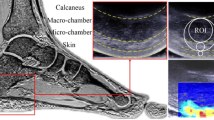Abstract
Experimental measurements of stresses and strains for lower extremity injuries (LEI) are invasive, and therefore, predictions require physiologically accurate 3D finite element (FE) models of the foot and ankle. In previous models, skin is typically neglected. However, experimental studies have shown that skin is much stiffer than soft tissue. In this study, the material sensitivity of skin on foot arch deformation is investigated. A finite element model of the foot is developed, incorporating bones, soft tissue, ligament, articulating surfaces, plantar aponeurosis, skin and plantar plate. Balanced standing is simulated without skin or with three different skin mechanical properties. By including different skin models, the foot static vertical stiffness, navicular displacement and plantar aponeurosis strain change significantly, when compared with the model without skin. The study shows that skin, showing a much stiffer behaviour than soft tissue, should not be neglected in the foot modelling. Further, the plantar plate considered in this model can give merit to modelling injuries such as plantar plate tearing.
Similar content being viewed by others
References
BANDAK F A, TANNOUS R E, TORIDIS T. On the development of an osseo-ligamentous finite element model of the human ankle joint [J]. International Journal of Solids and Structures, 2001, 38(10-13): 1681–1697.
CHEN W P, TANG F T, JU C W. Stress distribution of the foot during mid-stance to push-off in barefoot gait: a 3-D finite element analysis [J]. Clinical Biomechanics, 2001, 16(7): 614–620.
GEFEN A. Stress analysis of the standing foot following surgical plantar fascia release [J]. Journal of Biomechanics, 2002, 35(5): 629–637.
CHEUNG J T M, ZHANG M, AN K N. Effect of Achilles tendon loading on plantar fascia tension in the standing foot [J]. Clinical Biomechanics, 2006, 21(2): 194–203.
TAO K, WANG D M, WANG C T, et al. An In Vivo Experimental Validation of a Computational Model of Human Foot [J]. Journal of Bionic Engineering, 2009, 6(4): 387–397.
SARRAFIAN S K. Functional characteristics of the foot and plantar aponeurosis under tibiotalar loading [J]. Foot Ankle, 1987, 8(1): 4–18.
LEMMON D, SHIANG T Y, HASHMI A, et al. The effect of insoles in therapeutic footwear -A finite element approach [J]. Journal of Biomechanics, 1997, 30(6): 615–620.
HSU C C, TSAI W C, CHEN C P C, et al. Effects of aging on the plantar soft tissue properties under the metatarsal heads at different impact velocities [J]. Ultrasound in Medicine and Biology, 2005, 31(10): 1423–1429.
WRIGHT D G, RENNELS D C. A STUDY OF THE ELASTIC PROPERTIES OF PLANTAR FASCIA [J]. Journal of Bone and Joint Surgery-American Volume, 1964, 46(3): 482–492.
PAVAN P G, STECCO C, DARWISH S, et al. Investigation of the mechanical properties of the plantar aponeurosis [J]. Surgical and Radiologic Anatomy, 2011, 33(10): 905–911.
JANSEN L H, ROTTIER P B. Some mechanical properties of human abdominal skin measured on excised strips: a study of their dependence on age and how they are influenced by the presence of striae [J]. Dermatologica, 1958, 117(2): 65–83.
VOGEL H G. Age dependence of mechanical and biochemical properties of human skin [J]. Bioengineering and the Skin, 1987, (3): 67–91.
JACQUEMOUD C, BRUYERE-GARNIER K, CORET M. Methodology to determine failure characteristics of planar soft tissues using a dynamic tensile test [J]. Journal of biomechanics, 2007, 40(2): 468–475.
CHEUNG J T, ZHANG M, LEUNG A K, et al. Threedimensional finite element analysis of the foot during standing -A material sensitivity study. [J]. Journal of Biomechanics, 2005, 38: 1045–1054.
FONTANELLA C G, FAVARETTO E, CARNIEL E L, et al. Constitutive formulation and numerical analysis of the biomechanical behaviour of forefoot plantar soft tissue [J]. Proceedings of the Institution of Mechanical Engineers Part H-Journal of Engineering in Medicine, 2014, 228(9): 942–951.
WEARING S C, SMEATHERS J E, URRY S R. The effect of plantar fasciitis on vertical foot-ground reaction force [J]. Clinical Orthopaedics and Related Research, 2003, (409): 175–185.
SHEPHERD D E T, SEEDHOM B B. The’ instantaneous’ compressive modulus of human articular cartilage in joints of the lower limb [J]. Rheumatology (Oxford), 1999, 38(2): 124–132.
SIEGLER S, BLOCK J, SCHNECK C D. The mechanical characteristics of the collateral ligaments of the human ankle joint [J]. Foot & ankle, 1988, 8(5): 234–42.
KOGLER G F, SOLOMONIDIS S E, PAUL J P. Biomechanics of longitudinal arch support mechanisms in foot orthoses and their effect on plantar aponeurosis strain [J]. Clinical Biomechanics, 1996, 11(5): 243–252.
LEDOUX W R, BLEVINS J J. The compressive material properties of the plantar soft tissue [J]. Journal of Biomechanics, 2007, 40(13): 2975–2981.
CAMACHO D L A, LEDOUX W R, ROHR E S, et al. A three-dimensional, anatomically detailed foot model: A foundation for a finite element simulation and means of quantifying foot-bone position [J]. Journal of Rehabilitation Research and Development, 2002, 39(3): 401–410.
ANDERSON D D, GOLDSWORTHY J K, LI W, et al. Physical validation of a patient-specific contact finite element model of the ankle [J]. Journal of Biomechanics, 2007, 40(8): 1662–1669.
GEFEN A. The in vivo elastic properties of the plantar fascia during the contact phase of walking [J]. Foot Ankle Int, 2003, 24(3): 238–44.
DUAN X, LI L, WEI D Q, et al. Role of magnetic resonance imaging versus ultrasound for detection of plantar plate tear [J]. Journal of Orthopaedic Surgery and Research, 2017, 12: 14.
Acknowledgement
The authors thanks to Dr. WANG Dongmei from Mechanical Engineering School in Shanghai Jiao Tong University for providing genuine advice and the geometry files of the developed finite element model.
Author information
Authors and Affiliations
Corresponding author
Additional information
Foundation item: the National Natural Science Foundation of China (Nos. 51550110233 and 51505282)
Rights and permissions
About this article
Cite this article
Ou, H., Qaiser, Z., Kang, L. et al. Effect of Skin on Finite Element Modeling of Foot and Ankle During Balanced Standing. J. Shanghai Jiaotong Univ. (Sci.) 23, 132–137 (2018). https://doi.org/10.1007/s12204-018-1918-9
Received:
Published:
Issue Date:
DOI: https://doi.org/10.1007/s12204-018-1918-9




